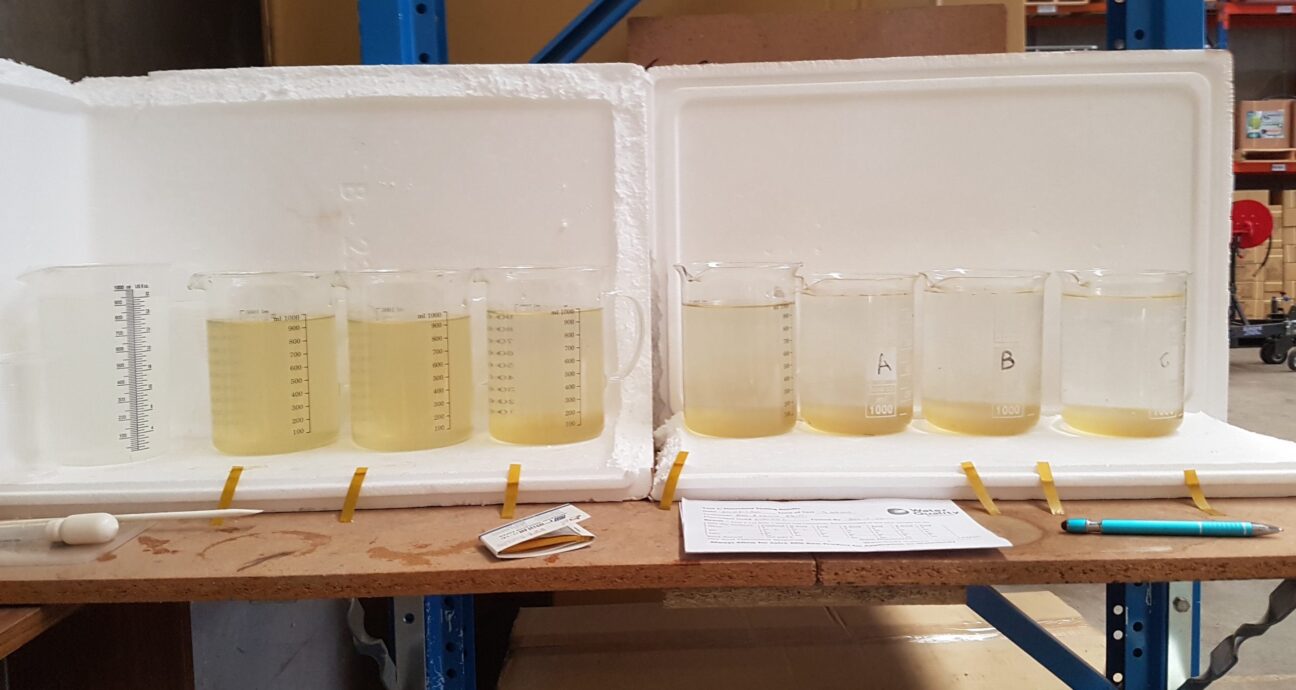It goes without saying that having a high level of water quality is essential if you’re looking to build a thriving pond or dam ecosystem.
While there are several high-tech water quality testing services and kits available on the market, often it’s your own intuition that you can rely on. You can generally tell a lot about the state of your water simply by relying on look and smell, as well as the lifeforms residing inside. If you see a highly diverse range of macroinvertebrates swimming around, then chances are you have a healthy water environment.
If you’re looking to monitor long term trends in your water system, then lab testing might be the better option. But testing water via a laboratory can be expensive, can take a long time, and any problem that is uncovered will likely be solved by a combination of aeration and probiotics, such as Biostim. You won’t likely need an expensive payment to find this out.
Most of the tests below are DIY and do not require a lab.
Best Practices for Dam Water Testing
Before we get into tests themselves, let’s quickly take a look at some of the best practices for making sure your testing achieves the most accurate results:
- Sample at multiple spots: Water is an ever-changing mass and is never fully consistent. If you just test in one spot, you might not get the full picture of what’s going on in your waterways. Additionally, surface water and deeper water can differ significantly, so test in both areas.
- Track changes over time: A single test isn’t particularly useful at identifying trends, or understanding if something is getting better or worse. That’s why you should choose a set of metrics and see how they change over time via regular testing.
- Act quickly: If you happen to notice something is clearly off, then don’t waste time with complicated chemical testing. Use some tried-and-tested solutions, such as aeration, reducing agricultural runoff, or biological solutions, i.e. Biostim, to counter the threat early.
Now that we’ve highlighted some of the best practices that you should be following, let’s dive into the tests. You should use a combination of these depending on your particular issue. If you’re unsure which ones to go with, we offer free advice to all current and prospective customers should you require any further help.
Quick Reference Table
|
Test |
Why it Matters | Healthy Range/Safe Level |
DIY or Lab? |
|
Macroinvertebrates |
Overall ecosystem health indicator | Diverse insect life | DIY/Lab |
| pH levels | Fish health, nutrient balance | 6.5-9.0 |
DIY |
|
Alkalinity |
Prevents pH swings | 50-200mg/l | DIY/Lab |
| Dissolved Oxygen (DO) | Fish survival, bacterial activity | >5mg/l |
DIY |
|
Temperature |
Fish stress, algae levels | <25-30°C | DIY |
|
Turbidity |
Light penetration and sediment build-ups | 30-60cm visibility |
DIY |
| Algae Cell Count | Predicts bloom risk | Low, stable counts |
DIY/Lab |
|
Blue-Green Algae |
Toxin risk | None present | DIY/Lab |
| Phosphorus | Main driver for algae blooms | <0.05mg/l |
Lab |
|
Nitrate |
Fuels algae growth | <10mg/l | DIY |
| Ammonia | High toxin risk | Zero |
DIY |
1. Macroinvertebrates
As mentioned, macroinvertebrates should be the first thing you look for when determining whether your water is healthy. They are natural indicators of positive water health as they are able to survive and thrive in such conditions. If these critters are missing, you might have a problem.
How to test: Use a dip net to collect samples from vegetation and sediment. Sample different areas and try to count the number of species in each collection as best you can.
What to look for: Mayflies, caddisflies, and dragonflies are all good indicators. Worms and leeches are less so. You should also make sure that no one species is clearly dominant in terms of numbers.
DIY or lab? DIY – farm owners can sample themselves.
Solutions: add an aerator for oxygenation, and use Biostim to stimulate “good” microbial foundation. Create areas of habitat for insects, e.g. plants/rocks on/near banks.
2. pH levels
pH levels are key indicators to what is going on in water. Extreme levels of acidity or alkalinity will often kill fish and limit plant growth. It’s an important test as these levels can’t be judged by our natural senses.
How to test: Use a handheld pH meter or test strips. Test multiple areas.
What to look out for: You’re looking for a range between 6.5 and 9.0 to indicate good water pH levels.
DIY or lab? DIY – easy to measure with inexpensive kits.
3. Alkalinity
Alkaline measures your pond’s buffering capacity i.e. how well it resists sudden pH swings. Low alkalinity makes water unstable.
How to test: You can purchase alkalinity test kits for home use. They will usually consist of calcium carbonate. Alkalinity is measured in mg/L.
What to look out for: Aim for 50-200mg/L. If you record below 20mg/L, your pond is at risk of big pH fluctuations.
DIY or lab? Labs can provide more accurate, comprehensive results. But there are good home kits available.
4. Dissolved oxygen (DO)
Fish, aquatic life, and beneficial bacteria need oxygen. Low DO levels will naturally affect these lifeforms in a negative way.
How to test: Use a DO meter or chemical testing kit. Measure at different times of day (oxygen production via photosynthesis is more active during daylight hours) and in different locations for accuracy.
What to look out for: Healthy ponds should stay above 5mg/L. Levels below 3mg/L are stressful or even lethal for fish.
DIY or lab? DIY – portable meters are reliable for on-farm checks.
Solution: Use an aerator to increase oxygen levels in your water.
5. Temperature
Temperature controls oxygen levels, algae growth, and fish health. Warm water holds less oxygen and encourages algae blooms.
How to test: A thermometer or digital probe. Take readings at different depths and locations.
What to look out for: Ideal ranges vary by season, but sudden spikes or persistent warmth above 25-30 degrees celsius can stress aquatic life.
DIY or lab? DIY. Use a thermometer or digital probe.
Solution: You can use aeration to reduce stratification, dyes to reduce UV penetration, and dredging or excavation to increase water depth for cooler temperatures.
6. Turbidity
Turbidity measures how cloudy the water is. This is generally caused by excess sediment, algae, or runoff. High turbidity reduces sunlight for plants and can clog fish gills.
How to test: You should use a Secchi dish. This is a dish where the quadrants are painted black and white. It is submerged in the water to the point where you can no longer see the individual quadrants.
What to look out for: You should be looking for visibility to a depth of around 30-60cm. If the disk vanishes from view before that, you have high turgidity.
DIY or lab? DIY – Secchi dishes are affordable and easy to use.
Solution: You can opt for flocculant for inorganic murkiness to make it easier to remove. So, removing dirt and silt from water.
Note: If you’re trying to clear up murkiness caused by organic matter, i.e. dead plant debris, dead insects, excrement, then Biostim is what to use. We recommend Biostim Liquid or Powder for water column treatment.
7. Algae
Often a pond’s worst nightmare, even non-harmful algae can quickly dominate a space, blocking light for other plants.
How to test: This is quite an easy sight test. However, for more detailed analysis, you can send your water sample to a lab for this one.
What to look out for: You’re looking for sudden bursts in algae blooms that might cause a problem if not contained.
DIY or lab? You can do this yourself by visually making note of how much algae you have. Or you can send a sample to a lab to get a detailed cell count.
Solution: Through a combination of aeration and Biostim you can keep algae at bay.
8. Blue-green algae
Cyanobacteria, also known as blue-green algae, is particularly harmful and can cause severe water contamination if allowed to go unchecked.
Warning: blue-green algae can be toxic to people, pets, and livestock. Close off the water body to public visitation and don’t use the water for irrigation or livestock drinking.
How to test: You can use one of our specialist Blue-Green Algae Testing Kits to detect if their are toxins in your water. Take care to always use personal protective equipment (PPE) when collecting water samples as well as using the kit because the water will heat up via a chemical reaction during the process.
What to look out for: This kit does not measure the population of blue-green algae in your water. Rather, it measures the level of toxins. You’re looking for a removal of these levels through consistent testing.
DIY or lab? Our kits are designed to be very easy for home use, though labs can give exact levels and types.
Solution: Through a combination of aeration and Biostim you can starve off blue-green algae and prevent it from coming back. We don’t recommend using algaecide as this can shock the blue-green algae and trigger it to dump all its toxins at once. It’s better to starve it out slowly using aeration and probiotics.
9. Phosphorus and nitrate levels
These two elements are common by-products of excess agricultural runoff and fertilizer, as well as decomposing organic matter. Both are main drivers for excessive levels of algae growth, which will lead to the problems mentioned in earlier sections.
How to test: While you can test for nitrate yourself, we recommend measuring total reactive levels through more in-depth lab testing services for this particular problem.
What to look out for: For phosphorus, levels above 0.05mg/l can be an issue. For nitrate, you’re looking for ideal levels below 10mg/l.
DIY or lab? You’ll need to use a lab service here as there are no reliable DIY methods for testing phosphorus.
Solution: You can use Biostim PhosFix to help take care of water with high amounts of phosphorus.
10. Ammonia
Ammonia is highly toxic to fish and forms from decomposing waste and fertilisers. It is especially dangerous in warm or hot water systems with high-pH levels, so monitoring water quality for this element is vital.
How to test: You can use ammonia testing kits or digital probes.
What to look out for: There is very little leeway here – you should ideally have zero levels of ammonia for safe water levels.
DIY or lab? DIY kits will give reliable, on-site spot checks.
Solution: You can then use Nitrifying Bacteria to help eradicate the issue on the spot. To prevent future ammonia issues, we recommend increasing aeration and using Biostim.
Get FREE Advice
We offer expert advice on all things related to your dam and water systems. We can take a look at any photos, as well as the location of your dam, to help determine what’s going on and what can be done to help. Contact us for FREE expert advice.

